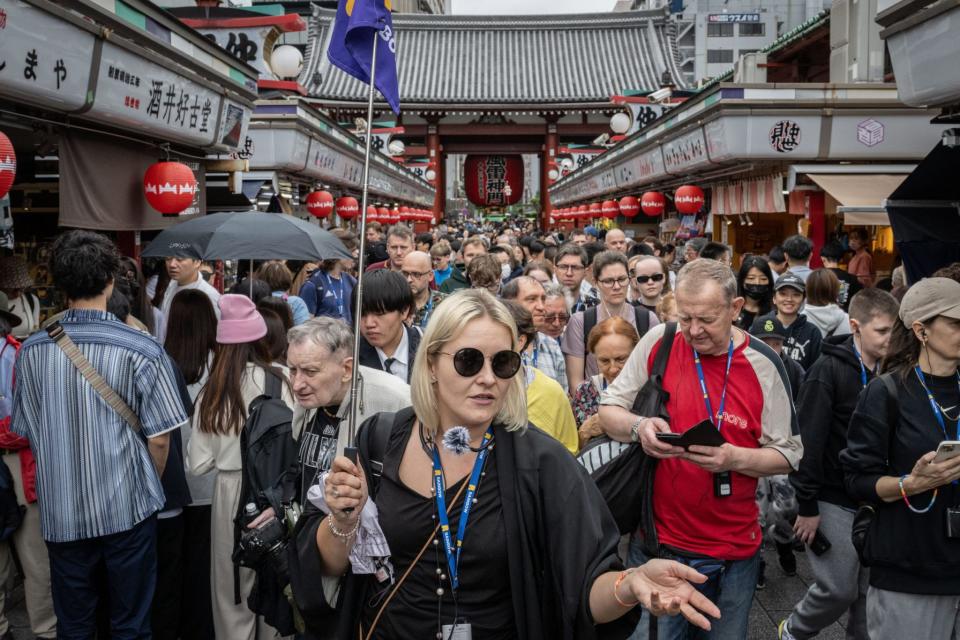The weak yen and ‘Instagram culture’ made tourism Japan’s second-largest export. Not everyone is happy about that

Everyone really is going to Japan this year.
Over 14.6 million international visitors went to Japan between January and May, according to data from the Japan National Tourism Organization. Almost 3.1 million went to the country in March alone, the highest monthly total since records began in 1964.
If that trend continues, Japan is set to exceed its record of 31.9 million tourists in 2019, just before the COVID pandemic.
Total inbound tourism spending rose to 1.75 trillion yen ($10.8 billion) in the first quarter of the year. That made tourism Japan’s second-largest “export”, just behind cars and ahead of products like semiconductors, according to Fortune’s calculations and data from Oxford Economics.
It’s the first time since the final quarter of 2019 that tourism spending is in second place, notes Oxford Economics’ senior Japan economist Norihiro Yamaguchi. Inbound travel almost vanished during the pandemic, but recovered quickly after Japan started lowering its COVID controls in September 2022. Japan lifted all restrictions in April 2023.
Tourists in Japan now have a lot of spending power, as the yen hits record lows against the U.S. dollar. That’s making hotels, sightseeing and family meals cheaper for foreign visitors than they would have been before the pandemic.
But Jeremy Bek, the global head for Japanese travel platform Rakuten Travel, thinks the surge in Japanese travel is about more than just a weak currency.
Visitors now want unique social media-ready experiences rather than just food and shopping. “It’s the Instagram culture, right?” Bek says. “It’s not about what you eat or what you do. It’s about what people see you eat and do. And Japan is beautiful. There’s so many beautiful things to put on Instagram.”
How is a weak yen helping tourism?
The yen, long a safe haven for investors during times of crisis, has declined against the dollar. A year ago, one U.S. dollar was worth 140 yen; it's worth around 161 yen now.
The U.S. Federal Reserve’s “higher-for-longer” stance on rates makes the U.S. dollar more attractive to investors and puts pressure on many Asian currencies.
Japan resisted raising its interest rates as it fought a decades-long battle against deflation. The Bank of Japan kept its key interest rate in negative territory even as other central banks tried to match U.S. central bank's moves during the hiking cycle between 2022 and mid-2023.
In March, Japan’s central bank hiked interest rates above zero for the first time in 17 years. The rate hike came after Japanese companies agreed to large pay increases, giving hope that Japanese consumers might start spending more and boost the economy.
Japanese companies typically viewed a weak yen as a good thing as it lowers the cost of exports and increases the value of repatriated overseas profits. But the yen may now be too weak for corporate Japan’s liking, as expensive imports eat away at margins and depress consumer spending.
Even Japan Airlines—a company that relies on travel for its revenue—is growing wary of the weak yen, as outbound travel becomes prohibitively expensive for many Japanese.
Why is Japan complaining about overtourism?
Rakuten Travel is benefiting from the boom in Japanese travel. Bookings surged 75% in the first quarter of 2024 compared to the same quarter in 2019, before the COVID pandemic, Bek says. Gross transaction value is also up 200% over the same period.
Japanese government data reports most tourists are coming from South Korea, mainland China, Taiwan, and Hong Kong.
Bek says tourists are looking for more authentic and comprehensive experiences, rather than the major sights of Tokyo and Osaka. Non-metro bookings are surging faster than metro bookings, as travelers look for experiences like Kaiseki dinners, hot springs, and nature experiences in second- or third-tier cities, says Bek quoting Rakuten Travel's data.
Some Japanese residents are grumbling about the travel surge, complaining about overcrowding and tourists’ poor manners. (Several other tourist destinations, like Spain and Greece, are also experiencing a backlash to "overtourism.")
In Kyoto, a major tourist attraction, a mayoral candidate even won office thanks to complaints about tourists. Koji Matsui campaigned against overtourism, citing unhappiness with tourists lugging suitcases onto crowded public transport.
In another instance, the Japanese town of Fujikawaguchiko erected a barrier blocking a famous photo spot of Mr. Fuji. Locals were annoyed with the ever-increasing number of tourists littering, trespassing, and breaking traffic rules in their hunt for a social media-worthy photo.
Still, tourists are undeterred in their quest for the perfect shot. People are poking holes in the barrier to take photos, Bek says.
The influx of visitors has pushed some attractions and businesses to consider dual pricing, with a regular price for Japanese residents and a higher price for tourists.
Himeji is considering asking foreigners to pay more to see the 400-year-old Himeji Castle, a UNESCO World Heritage Site, ostensibly to help fund required maintenance.
Kyoto mayor Matsui is pushing for higher fares for tourist to ease the stress on public transport; the city has also introduced express sightseeing buses that only stop at major tourist spots.
Yet Bek thinks the concerns about overtourism are mostly limited to major cities like Tokyo, Kyoto and Osaka. Less prominent cities aren't "overpopulated" yet, he says.
Fortunately for tourists, Bek says the hotels he works with aren’t considering making foreigners pay more. Bek notes that hotels still have enough inventory to cater to both inbound and domestic tourists. Even with the travel boom, he thinks Japan’s hotels are playing it safe when it comes to capacity.
“They don’t want a repeat of the COVID situation,” he says. “If they rely too much on international tourists, and then things get shut down, they’re left without any customers.”
This story was originally featured on Fortune.com

 Yahoo Finance
Yahoo Finance 